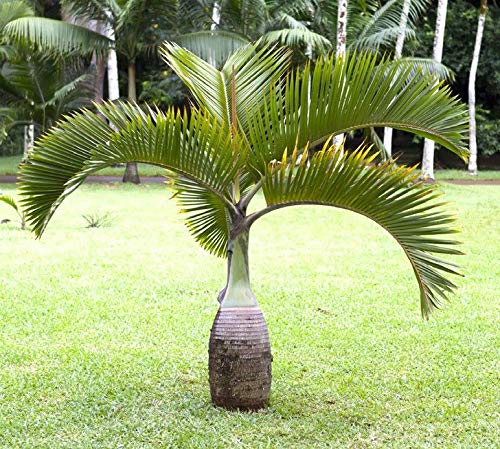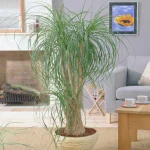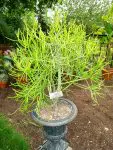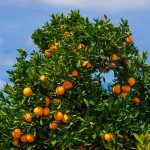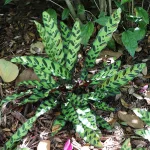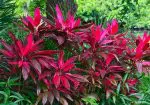This post contains affiliate links. If you buy something from one of our links we may earn a commission. Thanks
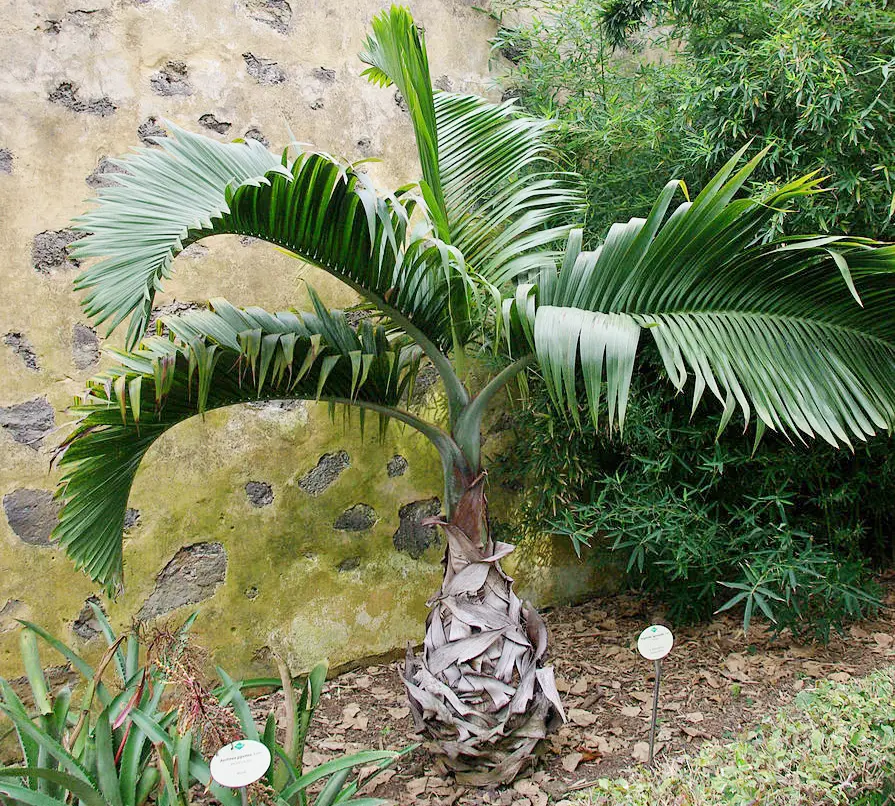
The Bottle Palm Tree is a unique and fascinating indoor plant, known for its distinctive shape and lush foliage.
Bottle Palm (Hyophorbe lagenicaulis) Indoor Care entails placing it in a well-lit area, preferably with indirect sunlight, and maintaining temperatures between 70-80°F.
Watering should be moderate, letting the soil dry between waterings, and well-draining soil is crucial to prevent root rot. Regular fertilization during the growing season and ensuring high humidity will help the palm thrive indoors.
Its scientific name, Hyophorbe lagenicaulis, reflects its elegant appearance and strong, hardy nature, and standout silhouette.
The name is from two Greek words, lagen meaning flask, and caulis meaning stem.
Whether you’re a seasoned plant enthusiast or just starting out, caring for a Bottle Palm Tree can be a rewarding experience.
The use of common plant names can be problematic. For example, this plant is often confused with and sold as the ponytail palm (Beaucarnea recurvata) but they are different species.
In fact, the ponytail palm isn’t even a palm but still makes a great houseplant. If you want to learn more about the ponytail palm we have a separate article about it.
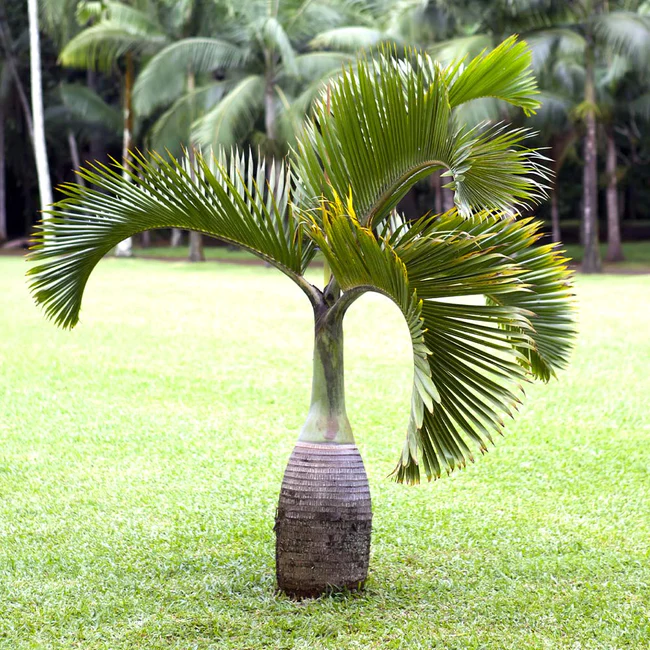
But if you want to learn about Bottle Palm Indoor Care you are in the right place.
Bottle Palm Quick Facts
| Mature Height: | 5-7 ft Indoors 10-20 ft Outdoor |
| Mature Width: | 6-8 ft Indoors 10-15 ft Outdoors |
| Sunlight: | Full-Partial |
| Growth Rate: | Slow |
| Botanical Name: | Hyophorbe lagenicaulis |
| Grows Well In Zones: | 4-11 patio / 10-11 outdoors |
You can buy Bottle Palm seeds on Amazon
To keep your Bottle Palm thriving, it’s essential to provide it with proper care. This is where our bottle palm indoor care guide comes into play.
This article will provide you with all the essential information you need for successful Bottle Palm Indoor Care.
From light and water requirements to tips for avoiding common problems, you’ll have everything you need to keep your Bottle Palm Tree thriving and looking its best.
So, if you’re ready to learn how to care for one of nature’s most beautiful indoor plants, read on!
What Is A Bottle Palm Tree?
The Bottle Palm Tree, also known as Hyophorbe lagenicaulis, is a unique and attractive indoor plant that is native to the Mascarene Islands near Madagascar.
It is named after its distinctive bottle-shaped trunk that can store water, allowing the plant to survive long periods without water.
These beautiful palms palm are an excellent choice for those looking to add a touch of tropical beauty to their indoor spaces.
The Importance Of Bottle Palm Indoor Care:
The Bottle Palm Tree is a relatively low-maintenance indoor plant, but proper care is still essential for its health and longevity.
This includes providing adequate light, water, temperature, and humidity levels, as well as fertilizing and pruning as needed.
By taking the time to understand and meet the needs of your Bottle Palm Tree, you can ensure that it remains healthy and vibrant for years to come.
Tip 1: Light Requirements
Proper lighting is an essential component of indoor care for the Bottle Palm Tree.
Adequate light not only ensures the overall health and vitality of the plant but also contributes to its attractive appearance.
Understanding the light requirements of your Bottle Palm Tree, including the amount of light it needs, the best placement for light, and the signs of over/under exposure to light, is crucial for its success as a houseplant.
In this section, we will explore these light requirements in detail to help you provide the best possible care for your Bottle Palm Tree.
Amount of Light Needed:
The Bottle Palm Tree requires bright light to thrive. This means that it should be placed near a window that receives plenty of natural light.
If you do not have a bright enough location in your home, you may need to supplement with artificial light.
Best Placement for Light:
When choosing a location for your Bottle Palm Tree, look for a spot near a window that receives plenty of natural light, this plant can take full sun.
If you do not have a bright enough location, you can use LED or fluorescent lights to supplement it.
Signs of Over/Under Exposure to Light:
Overexposure to direct sunlight can cause the leaves of the Bottle Palm Tree to yellow and become scorched.
On the other hand, underexposure to light can cause the leaves to become pale and stretch out in search of more light.
If you notice these symptoms, adjust the placement of your Bottle Palm Tree to ensure that it is getting the right amount of light.
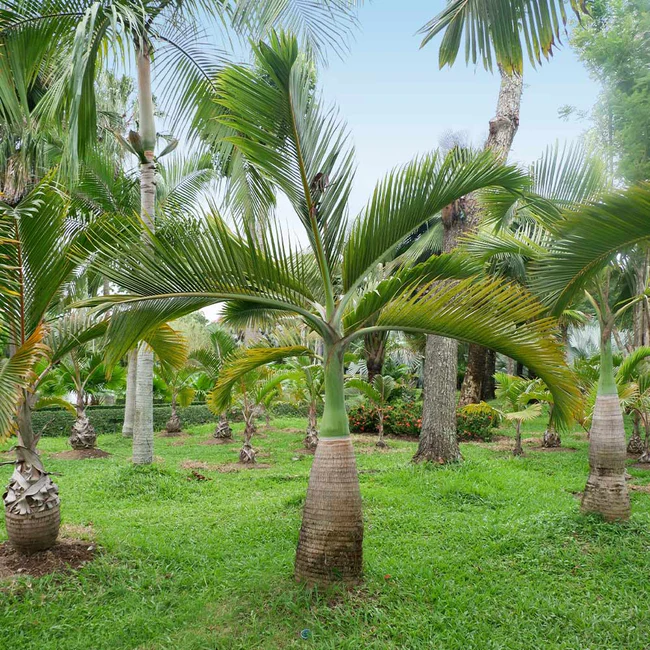
Tip 2: Soil and Pot Requirements
The bottle palm (Hyophorbe lagenicaulis) is a unique and attractive indoor plant that requires special care to thrive.
One of the important factors in the care of the bottle palm is the soil and pot it is grown in.
The ideal soil for the bottle palm should be well-draining and slightly acidic.
It is also important to choose a pot that is large enough to allow for proper root growth, but not too large that it holds too much moisture.
This palm is a slow grower so don’t overpot it.
Finally, it is important to repot the bottle palm regularly to ensure that it has enough room for healthy growth and to refresh the soil.
This section will cover the ideal soil, pot size, and frequency of repotting for bottle palm indoor care.
Ideal Soil for Bottle Palm
The ideal soil for the bottle palm should be well-drained soil and slightly acidic, with a pH between 6.0 to 7.0.
A good quality potting mix that contains peat moss, perlite, and sand is recommended.
A 50/50 mix of perlite and coco coir makes an excellent potting medium for this plant.
The soil should be moist but not waterlogged, as the bottle palm is susceptible to root rot.
It is important to avoid using heavy or clay soils that retain too much moisture.
Proper Pot Size
When selecting a pot for the bottle palm, it is important to choose one that is large enough to accommodate the plant’s root system but not too large that it holds too much moisture.
A pot that is one to two sizes larger than the current pot is recommended. If the roots have filled the current pot and are growing out of the drainage holes, it’s time to repot into a larger pot.
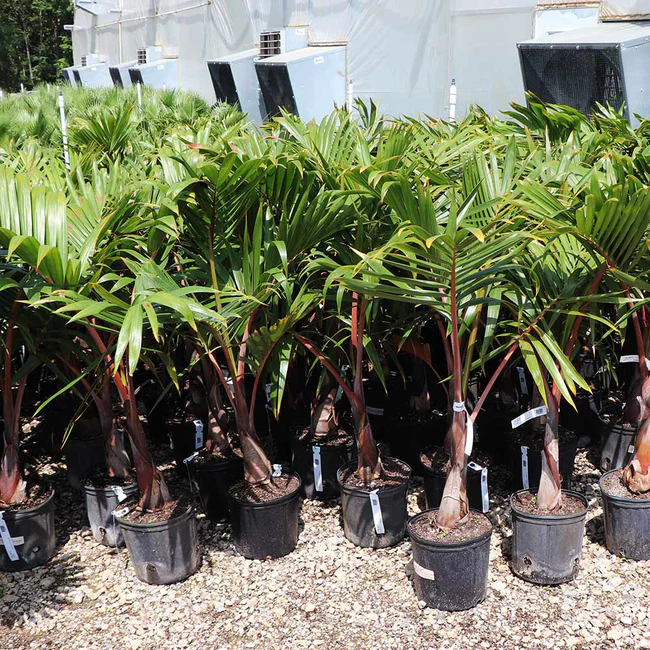
How Often to Repot
The frequency of repotting depends on the rate of growth of the bottle palm. As a general rule, repotting should be done every two to three years, or when the roots have filled the current pot and are growing out of the drainage holes.
When repotting, be careful not to damage the root system, and water the plant thoroughly after repotting.
These palm varieties typically have slow growth and don’t have extensive root systems so don’t need repotting often making them a great choice as a potted plant.
In conclusion, the soil and pot size are important factors in the care of the bottle palm.
By selecting the right soil, pot size, and repotting frequency, you can ensure that your bottle palm has the right conditions to grow healthy and strong.
Tip 3: Watering Requirements:
Watering is another important aspect of indoor care for the Bottle Palm Tree.
This plant has the unique ability to store water in its trunk, which makes it relatively drought-tolerant.
However, it is still important to provide the right amount of water to keep the plant healthy and thriving.
In this section, we will discuss the frequency of watering, the amount of water needed, soil moisture requirements, and how to prevent over- or under-watering.
Understanding these watering requirements will help you keep your Bottle Palm Tree hydrated and healthy.
Frequency of Watering:
The Bottle Palm Tree is relatively drought-tolerant and does not need to be watered frequently.
In fact, it is important not to overwater this plant, as this can lead to root rot. This plant actually prefers growing in drier soils.
During the growing season, which is typically spring, summer, and early fall you should water your Bottle Palm Tree once a week, or when the top inch of soil is dry to the touch.
During the dormant season, you can reduce watering to once every two to three weeks.
Amount of Water Needed:
When you do water your Bottle Palm Tree, it is important to give it a thorough soaking.
This means watering it until you see water coming out of the bottom of the pot.
Be sure to empty any excess water from the saucer after watering to prevent root rot.
Soil Moisture Requirements:
The Bottle Palm Tree prefers well-draining soil that does not become waterlogged.
A good quality potting mix, combined with good drainage holes in the pot, will help ensure proper soil moisture levels.
Prevention of Over/Under Watering:
Over-watering is one of the biggest threats to the health of the Bottle Palm Tree.
You can use your fingers to check the moisture level or you can use a moisture meter.
To prevent overwatering, be sure to allow the top inch of soil to dry out between waterings, and make sure the pot has good drainage.
On the other hand, underwatering can cause the leaves to turn brown and crispy.
To prevent under-watering, be sure to water your Bottle Palm Tree regularly, and take into account factors such as the time of year and the level of humidity in your home.
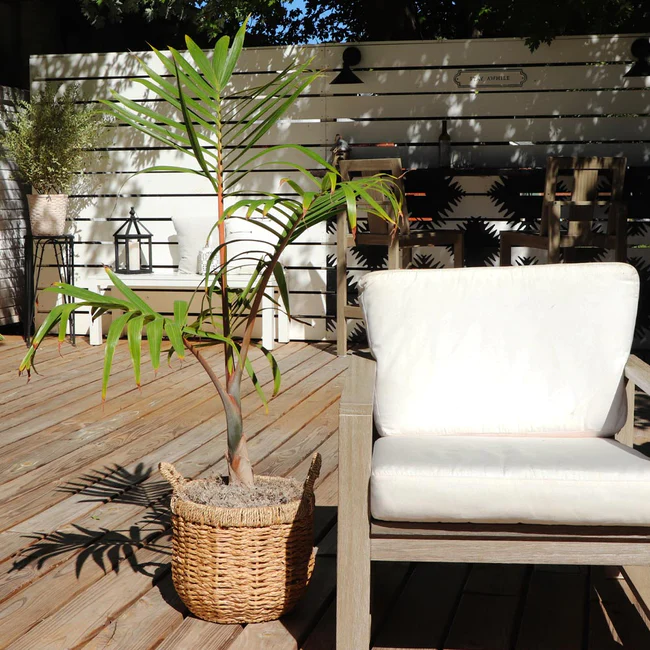
Tip 4: Temperature Requirements:
The Bottle Palm Tree is a tropical plant and prefers warm temperatures.
In order to provide the best possible indoor environment for your plant, it is important to understand the temperature requirements and how to regulate the temperature in your home.
In this section, we will discuss the ideal temperature range for the Bottle Palm Tree, how to maintain consistent temperatures, and how to protect the plant from extreme temperature changes.
Understanding these temperature requirements will help you keep your Bottle Palm Tree healthy and thriving in your home.
Ideal Temperature Range:
The Bottle Palm Tree prefers warm temperatures and should be kept in a room with a temperature between 65°F to 85°F (18°C to 29°C).
It is important to maintain consistent temperatures, as sudden temperature changes can stress the plant.
Prevention of Extreme Temperatures:
It is important to protect the Bottle Palm Tree from extreme temperature changes, as this can damage the plant.
Avoid placing the plant near windows or doors that open to the outside, as this can cause temperature fluctuations.
You should also avoid placing the plant near heating or cooling vents, as this can cause the temperature to drop dramatically.
Effects of Over/Under Heating/Cooling:
Overheating or over-cooling can cause stress to the Bottle Palm Tree, leading to yellowing leaves and other symptoms of distress.
On the other hand, cooler temperatures can slow the plant’s growth, or even cause it to die.
To avoid these problems, it is important to maintain consistent temperatures within the ideal range. Even a light frost can damage these palms.
The bottle palm can be grown outdoors in parts of Southern California and lower parts of Florida.
Elsewhere smaller trees can be kept in pots and brought outdoors during the summer months.
Be careful to gradually acclimate them to sunlight and start them out receiving bright indirect light, even some partial shade will be fine.
Tip 5: Humidity Requirements:
The Bottle Palm Tree is native to tropical climates, and therefore requires a certain level of humidity to thrive.
In order to provide the best possible indoor environment for your plant, it is important to understand the humidity requirements and how to regulate the humidity in your home.
In this section, we will discuss the ideal humidity range for the Bottle Palm Tree, how to maintain consistent humidity levels, and how to prevent low humidity levels.
Understanding these humidity requirements will help you keep your Bottle Palm Tree healthy and thriving in your home.
Ideal Humidity Level:
The Bottle Palm Tree prefers a humidity level of around 50% to 60%. If the humidity level in your home is lower than this, you may need to take steps to increase the humidity around the plant.
Increase Humidity (if necessary):
If the humidity level in your home is too low, there are several ways to increase the humidity around the Bottle Palm Tree.
These include: misting the leaves regularly, placing a humidifier near the plant, using a pebble tray, or grouping plants together to create a more humid microclimate.
Signs of Over/Under Humidity:
Over-humidity can lead to root rot in the Bottle Palm Tree, so it is important to monitor the humidity level and take steps to prevent over-humidity.
Signs of over humidity include yellowing leaves, wilting, or a mushy texture to the potting soil.
Under humidity can cause the leaves to turn brown and crisp, so it is important to increase the humidity if necessary.
To monitor the humidity level, you can use a hygrometer, which is a device that measures the humidity in the air.
Tip 6: Fertilizing Requirements:
Providing proper nutrition is an important aspect of indoor care for the Bottle Palm Tree.
Fertilizing helps to support the plant’s growth, enhance its health, and promote lush foliage.
In this section, we will discuss the fertilizing requirements for the Bottle Palm Tree, including the best types of fertilizer, the frequency of fertilizing, and the proper application technique.
By following these guidelines, you will be able to provide the essential nutrients your Bottle Palm Tree needs to thrive.
Frequency of Fertilizing:
The Bottle Palm Tree should be fertilized every 2-3 months during the summer months. Its growing season is typically from early spring to late fall.
During the winter months, when the plant is dormant, it is best to reduce or stop fertilizing altogether.
Type of Fertilizer Needed:
Balanced, water-soluble palm fertilizers are best for the Bottle Palm Tree. Look for a fertilizer with an NPK ratio of 20-20-20, which provides a balanced mix of essential nutrients, including nitrogen, phosphorus, and potassium.
Signs of Over/Under Fertilizing:
Over-fertilizing can lead to salt buildup in the soil, which can harm the roots of the Bottle Palm Tree.
Signs of over-fertilizing include brown tips on the leaves, yellowing leaves, or a general lack of growth.
Under-fertilizing can cause the leaves to turn yellow and the growth to slow, so it is important to fertilize regularly to provide the essential nutrients the plant needs to thrive.
To prevent over/under-fertilizing, it is best to follow the recommended frequency and application techniques for the type of fertilizer you are using.
Tip 7: Pruning Requirements:
The Bottle Palm Tree is a slow-growing plant and does not require frequent pruning. In fact, minimal pruning is recommended to maintain the plant’s natural shape and appearance.
In this section, we will discuss the benefits of pruning, the proper techniques for pruning, and how to avoid over-pruning.
By following these guidelines, you will be able to provide the proper care to your Bottle Palm Tree and help it to grow and flourish.
Frequency of Pruning:
The Bottle Palm Tree requires minimal pruning, and it is recommended to prune the plant only when necessary.
This typically involves removing old or yellowing branches and keeping the trunk clean.
Pruning should be done sparingly to maintain the plant’s natural shape and growth.
Types of Pruning:
The Bottle Palm Tree can be pruned by removing yellowing or dead branches. By keeping the trunk clean of old branches it will develop its bottle-like appearance.
When removing yellowing or dead branches, make sure to use clean, sharp pruning shears to make clean cuts.
Be careful not to damage the trunk when pruning off lower dead branches.
Importance of Pruning for Indoor Care:
Pruning is an important aspect of indoor care for the Bottle Palm Tree because it helps to promote healthy growth and maintain the plant’s natural shape.
By removing old or yellowing branches, you will improve the plant’s appearance and help it to grow more efficiently.
Additionally, keeping the trunk clean will help to prevent disease and improve the overall health of the plant.
Regular, minimal pruning will help to keep your Bottle Palm Tree healthy and thriving for many years to come.
Tip 8: Bottle palm pests and diseases and treatments
The Bottle Palm, also known as the Hyophorbe lagenicaulis, is a beautiful and unique indoor plant that can add a touch of tropical charm to any home.
However, like any other plant, it can also be prone to various pests and diseases if proper care is not taken.
Understanding common bottle palm pests and diseases, as well as the treatments, is essential to keeping your plant healthy and thriving.
In this section, we will explore the most common pests and diseases that affect bottle palms and the best treatments to keep your plant free from harm.
Spider Mites: Tiny, spider-like pests that can cause yellowing and browning of leaves.
Mealy bugs: Small, white, cottony insects that feed on plant sap.
Scale insects: Small, brown, or black pests that attach to the stem or leaves of the plant and feed on its sap.
Symptoms and Treatments
Spider Mites: Leaves may become yellow and mottled and may have webs. Treatment involves regular watering, removing infested leaves, and applying an organic insecticide like insecticidal soap or neem oil.
Mealy bugs: Leaves may become yellow and sticky, and a cottony substance may be present. Treatment involves wiping the pests off with a cotton swab dipped in alcohol, applying insecticidal soap or neem oil, and improving air circulation around the plant.
Scale insects: Leaves may yellow and the plant may become stunted. Treatment involves scraping off the pests with a toothbrush or knife and applying horticultural oil or insecticidal soap.
Common Bottle Palm Diseases
Root rot: A fungal disease that can cause the roots to rot and the plant to wilt.
Leaf spot: A fungal disease that causes brown or black spots on the leaves.
Stem rot: A fungal disease that causes the stem of the plant to rot and become soft and mushy.
Symptoms and Treatments
Root rot: The plant may wilt and become stunted, even when soil moisture is adequate. Treatment involves removing the affected roots, improving soil drainage, and avoiding over-watering.
Leaf spot: Small, brown or black spots may appear on the leaves, which may eventually become yellow and fall off. Treatment involves removing affected leaves, improving air circulation, and applying a fungicide.
Stem rot: The stem of the plant may become soft and mushy, and the plant may wilt and eventually die. Treatment involves removing the affected stem and applying a fungicide.
It is important to take a proactive approach to pest and disease management for your Bottle Palm Tree.
Regularly inspecting the plant for signs of trouble, maintaining good cultural practices, and using preventative measures such as using neem oil or insecticidal soap can help to keep your Bottle Palm healthy and beautiful.
Tip 9: Common Problems and Solutions:
Despite its relatively low-maintenance nature, the Bottle Palm Tree may face certain issues that can impact its growth and appearance.
In this section, we will discuss some of the most common problems that indoor Bottle Palm Trees face and provide solutions to help resolve these issues.
By understanding the symptoms and causes of these problems, you will be able to take the necessary steps to maintain the health and well-being of your Bottle Palm Tree.
Yellowing Leaves:
One of the most common problems that indoor Bottle Palm Trees face is yellowing leaves.
This can be caused by a variety of factors, including over-watering, under-watering, high salt levels in the soil, nutrient deficiencies, or exposure to cold temperatures.
If the yellowing is severe, it may indicate root rot or a nutrient deficiency.
Brown Tips on Leaves:
Another common issue with indoor Bottle Palm Trees is brown tips on the leaves. This is often caused by low humidity, dry air, or exposure to high temperatures.
It can also be a sign of over-fertilization or a lack of nutrients.
Stunted Growth:
Stunted growth can be a sign of a variety of problems, including improper light, water, temperature, or soil conditions. It can also be a result of disease or pests.
Prevention and Solutions:
To prevent these problems, it is important to maintain the proper light, water, temperature, and humidity levels for your Bottle Palm Tree.
Regularly monitoring the plant’s appearance and addressing any issues promptly can help to prevent problems from becoming severe.
If yellowing leaves or brown tips on leaves occur, you may need to adjust your watering or fertilizing schedule.
If stunted growth is a concern, you may need to repot the plant or add additional fertilizer.
If you are unsure of the cause of the problem, consult a horticulturist or specialist for advice.
Bottle Palm FAQs
Growing a Bottle Palm indoors can be a rewarding experience but it comes with its own set of challenges.
As a tropical plant, it requires a certain level of care and attention to thrive indoors.
Below are some common questions and answers that can guide you on how to provide the best care for your Bottle Palm indoors:
Q. How often should I water my indoor Bottle Palm
A. Water your indoor Bottle Palm when the top inch of soil feels dry to the touch, typically once a week.
Q. What type of soil is best for Bottle Palm?
A. A well-draining soil mix of equal parts potting soil and perlite or sand is ideal for Bottle Palm.
Q. How much sunlight does a Bottle Palm need indoors?
A. Bottle Palms prefer bright, indirect sunlight indoors. A spot near a north or east-facing window is often suitable.
Q. How to manage pests on an indoor Bottle Palm?
A. For managing pests on an indoor Bottle Palm, regularly inspect the plant, keep it clean, and use insecticidal soap or neem oil to treat infestations.
Conclusion
Recap of Indoor Care Requirements:
To properly care for an indoor Bottle Palm Tree, it is important to provide the right amount of light, water, temperature, and humidity.
Additionally, it is important to fertilize regularly and prune the plant as necessary to maintain its health and appearance.
Final Thoughts on Bottle Palm Tree Care:
With proper care, an indoor Bottle Palm Tree can provide years of beauty and elegance to your home or office.
By following the guidelines outlined in this article, you can help to ensure that your Bottle Palm Tree thrives and grows to its full potential.
Remember to be patient and observant, and to consult a specialist if you are ever unsure about the best course of action for your plant.
With a little effort and attention, your Bottle Palm Tree will be a beloved and cherished addition to your indoor landscape for years to come.
Read our complete guide to indoor palm tree care.
You can buy Bottle Palm seeds on Amazon

